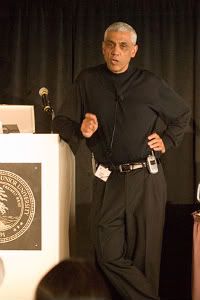Breakthrough Discoveries, Innovations and Renewable Energy – Guest-Blogger Kathy Heschelow – Continued

- DuPont and Bio Architecture Lab are developing a process to produce bio-butanol from seaweed. This project is funded through ARPA-E. (Geology. “Renewable Natural Gas from Algae”. May 2009).
- CalStar Products plans to build a factory that would make bricks from a by-product of coal burning (fly-ash). This may help reduce carbon-dioxide emissions.
- The Bloom Box from Bloom Energy has received much press since they revealed themselves publicly in February 2010. The chief officer K.R. Sridhar used sand to create wafers similar to floppy disks that serve as electrolytes. Says the New York Times, as fuel passes over the cells and mixes with oxygen ions, the reaction is electricity. Each cell generates 25 watts, and a 100 KW Bloom Server fits into the size of a parking space. A box of fuel cells could allow homes and businesses to generate their own electricity. Bloom spent about a decade working on its fuel-cell tech, and on a proprietary low-cost seal to prevent cracks and seals. About a year and a half ago, they installed 100 KW Bloom Boxes at several corporate giants for testing: eBay, Google, Wal-Mart, Bank of America, etc. These boxes apparently cost between $700,000 – $800,000 each, and a great deal of work will be needed to bring pricing down though Sridhar says the actual cost to generate electricity is low. Sridhar believes his application could power homes in five to ten years. (New York Times. “A Secretive Start-Up Raises the Curtain.” By Todd Woody. February 24, 2010).
- The world’s largest independent rotor blade manufacturer, LM Glasfiber, and several partners are developing a new laser-based wind sensing system. This is a three-year research project in Denmark that started in 2009 with financial support from the Danish National Advanced Technology Foundation. They believe the system, called ‘wind Lidar’, can predict wind direction, gusts and turbulence and the application will improve overall reliability and efficiency. Instead of measuring wind load after the fact, they will be able to measure wind in real-time and have the blade or turbine react instantly. This would not only create more efficiency but better energy yield, they say.
- A Virginia-based company, Catch the Wind, is working on a similar onshore system that will sense wind direction, speed and variations, called the Vindicator Laser Wind Sensor. The technology is a spin-off of the U.S.–based Optical Air Data Systems (OADS), an optical remote sensing technology founded in 1990. The OADS system is covered by 27 patents, and was created to improve flight safety. Catch the Wind acquired a technology license from OADS for non-aviation applications in 2008. By September 2009, Catch the Wind announced it had a manufacturing agreement with Canadian BreconRidge Corp, a fiber- optics specialist, who will provide design, technical, engineering and other services for manufacture of the Vindicator. Subsequently, Catch the Wind and the Nebraska Public Power District collaborated on a joint trial. The successful trial confirmed the Vindicator’s capabilities, says the company President. The system can see approaching winds 300 yards out, and allows the turbine to make changes immediately – for more efficiency. The company is also testing an offshore application. (Renewable Energy World. “Eye on the Wind: Innovations Designed to “See” and Track Gusts”, by Eize de Vries. March 16, 2010).
- Dr. Yet-Ming Chiang of MIT is working to improve the chemistry of lithium ion batteries that could be used for solar residential power and for hybrid vehicles. The current generation of these batteries, when used for large-scale storage, tends to burst into flames. Finding a safe way to store the sun’s unlimited sunlight is necessary to advance solar power and use of stronger batteries in cars.
I would like to highlight Daniel Nocera and his breakthrough work:
Daniel Nocera, a chemist and Dreyfus Professor of Energy at Massachusetts Institute of Technology (MIT) also runs the SunCatalytix company. He and fellow Matthew Kanan discovered an inexpensive and easy way to store energy which could change energy around the world. In a nutshell, he developed a technology that splits water into hydrogen and oxygen to enable storage of solar and wind energy for 24-hour use. The idea is that when the sun isn’t shining (at night, rainy days), you will have already collected and stored the solar power. Nocera says energy stored in the size of a water bottle could power an average U.S. home. The technology could be groundbreaking for areas where there is no power or power grid (countryside, third world countries, islands) but could also allow typical households to power themselves.
This project received some funding from ARPA. Nocera thinks this process will bring solar mainstream, stating that we can’t hope to have a solar economy unless it can be produced 24/7. The discovery was made in mid 2008 and the team has been working at improving, testing and finding the right way for all to use. His goal is a robust system that is low maintenance.
“Solar power has always been a limited, far-off solution. Now we can seriously think about solar power as unlimited and soon,” he said in Science on July 31, 2008. He is confident and hopes that within 10 years
U.S. homeowners will be able to power their homes in daylight through solar photovoltaic cells and power their own household fuel cell at other times with the excess stored energy.
Nocera asks on the MIT website – what will be the oil of the future? He hopes it is as simple as water plus sun.
There are many more technological advances in the works in many places and exciting technologies seem to be bubbling up. Turning a bottle of water into energy storage for a home is just one example. These advances will help green tech advance to become more efficient and more financially viable.

[…] Breakthrough Discoveries, Innovations and Renewable Energy … […]